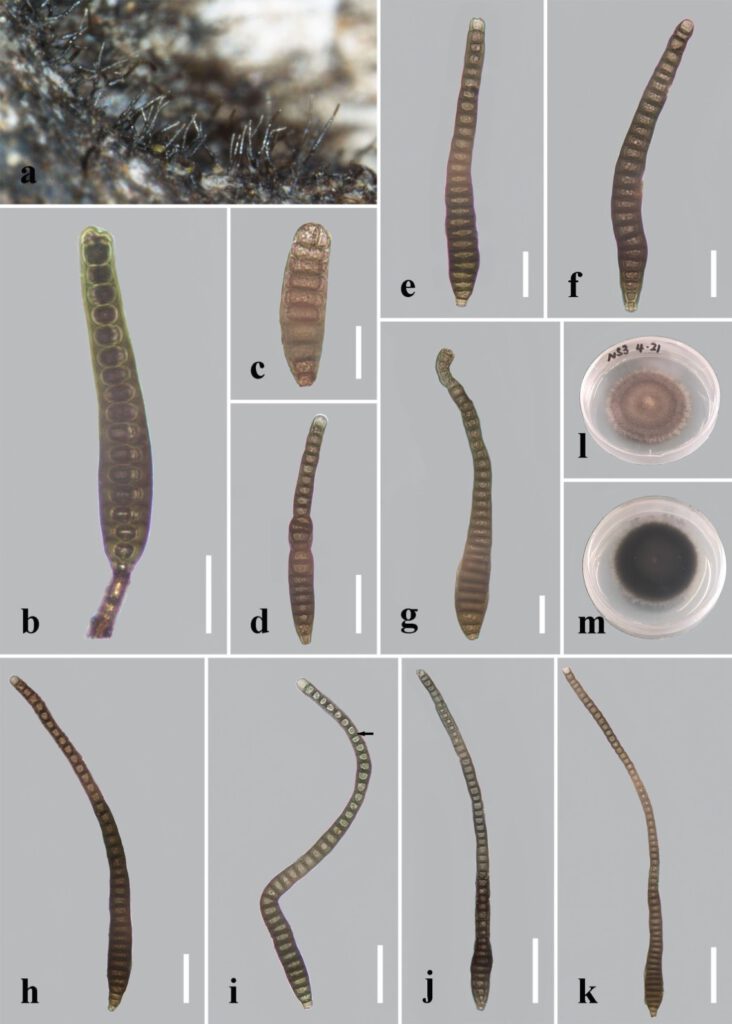Distoseptispora curvularia R. Zhu & H. Zhang, sp. nov.
MycoBank number: MB; Index Fungorum number: IF; Facesoffungi number: FoF 12578;
Description
Saprobic on decaying wood submerged in freshwater. Sexual morph: undetermined. Asexual morph: hyphomycetous. Colonies on the substratum superficial, effuse, scattered, hairy, dark-brown. Mycelium mostly immersed, composed of branched, septate, smooth, dark-brown hyphae. Conidiophores 11–28 μm long (x̄=18 µm, n=10), 5–9 μm wide (x̄=7 µm, n=10), macronematous, mononematous, unbranched, septate, cylindrical, straight or flexuous, smooth, brown to dark-brown, robust at the base. Conidiogenous cells 5–6 μm long, 5–5.5 μm wide, monoblastic, integrated, determinate, terminal, cylindrical, dark-brown, smooth. Conidia (60–)100–200(–314) µm long (rostrum included) (x̄=155 μm, n=30), 12–19 μm at the widest part (x̄=15 μm, n=30), 7–9.5 μm wide at the apex (x̄=9 μm, n=30), acrogenous, dry, obclavate, rarely oblong, rostrate, mostly curved, (9–)16–48(–59)-distoseptate, truncate at the base, rounded at the apex, smooth, thick-walled, brown with a green tinge.
Material examined: China, Yunnan Province, Xishuangbanna, Man Feilong Reservoir, found on dead, submerged, decaying wood of unidentified plants, 7 November 2020, Rong Zhu, N53 (HKAS 122180, holotype), ex-type living culture KUNCC 21–10725.
Distribution: China
Sequence data:ITS: OK310697 (ITS5/ITS4); LSU: OK341195 (LROR/LR5); TEF1a: OP413478 (983/2218R); RPB2: OP413472 (fRPB2-5F/fRPB2-7cR)
Notes: The new species has a close phylogenetic affinity to D. clematidis. Morphologically, D. curvularia is similar to D. clematidis in having acrogenous, obclavate, rostrate conidia and being brown with a green tinge. However, D. curvularia differs from the holotype of D. clematidis (MFLU 17–1501) in having longer conidia (up to 314 μm vs. up to 210 μm) and more conidial septa (up to 59 vs. up to 35). Additionally, our new collection of D. clematidis (KUNCC 21–10725) possesses conidia sometimes with percurrent proliferation and the formation of another conidium from conidial apices. A comparison of sequence data for these two species showed a difference of 15 (2.81%, no gaps) noticeable nucleotides in ITS gene regions. Therefore, we introduce D. curvularia as a new species.

Fig. x. Distoseptispora curvularia (holotype). (a) Colonies on natural substrate. (b) Conidiophores with conidium. (c–k) Conidia. The arrow in i points to a gap in the middle of the septum, which indicates the distosepta. (l) Colony on PDA (from front). (m) Colony on PDA (from reverse). Scale bars: (b–g) 20 μm; (h–i) 30 μm; (j–k) 50 μm.
